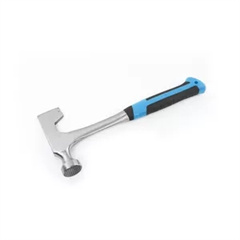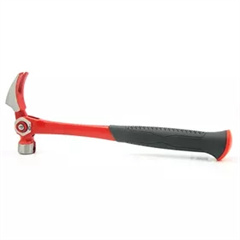Absolutely, specialized hammers are designed to cater to specific trades and tasks, optimizing efficiency and accuracy in various fields. Here are some examples of specialized hammers tailored to different trades:
- Carpentry Hammer:
- The classic carpenter’s hammer, often called a claw hammer, has a flat striking face for driving nails and a curved claw for pulling nails out of wood.
- Ball Peen Hammer:
- Used in metalworking, this hammer has a flat face for striking metal and a rounded peen on the opposite side for shaping and riveting.
- Sledgehammer:
- A large, heavy hammer with a long handle, used for heavy-duty tasks like demolition, driving stakes, and breaking concrete.
- Cross Peen Hammer:
- Similar to a ball peen hammer, but with a wedge-shaped peen instead of a rounded one, making it suitable for more precise metal shaping.
- Mallet:
- Often made of rubber, wood, or plastic, a mallet is used in woodworking to avoid damaging delicate surfaces while driving chisels or assembling joints.
- Club Hammer:
- Smaller and heavier than a standard sledgehammer, it’s used for light demolition and driving chisels in masonry work.
- Dead Blow Hammer:
- Filled with shot or sand, it minimizes rebound upon impact, making it suitable for tasks where control and precision are crucial.
- Soft-Faced Hammer:
- Used to prevent marring or damaging surfaces, these hammers have replaceable, non-marring faces made of materials like rubber or nylon.
- Tack Hammer:
- Designed for upholstery work, it has a magnetized face for holding tacks in place while hammering.
- Brick Hammer:
- Featuring a chisel-like end for splitting bricks and a hammer head for striking, it’s used in masonry for shaping and cutting bricks.
- Geologist’s Hammer:
- Also known as a rock hammer, it has a pick-like end for breaking rocks and a flat head for chiseling.
- Blacksmith’s Hammer:
- Comes in various forms, including rounding hammers, straight-peen hammers, and cross-peen hammers, each designed for specific metalworking tasks.
- Roofing Hammer:
- With a specialized claw for removing roofing materials and a flat face for driving nails, it’s ideal for roofers.
- Electrician’s Hammer:
- Designed with a pointed pick end for removing staples and a claw for pulling nails, suitable for electrical work.
- Framing Hammer:
- Heavier than a standard claw hammer, it’s used in construction for framing tasks and driving large nails.
- Automotive Hammer:
- Used by mechanics for tasks like shaping metal panels, removing dents, and aligning parts.
- Bush Hammer:
- A tool with a grid of pyramid-like points, used in masonry to create a rough texture on stone surfaces.
- Chasing Hammer:
- A jewelry hammer with a smooth face on one end and a slightly rounded end on the other, used in metalworking and jewelry-making.
Specialized hammers exemplify the principle of having the right tool for the job. They reflect the expertise and diverse demands of various trades, ensuring that tasks are completed efficiently and with precision.



































